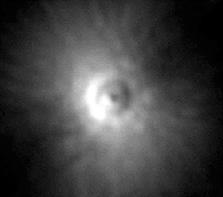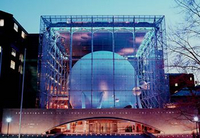|
|
|
|
|
|
Project 1640 - Removing the speckles |
|
The primary reason we cannot see exoplanets is our inability to remove the starlight in an imaging system while leaving the light from the planet unperturbed. We can remove more than 99% of the starlight using a coronagraph (see the Lyot Project) The image below is a coronagraphic image of a nearby star taken with the Lyot coronagraph behind the 941 actuator system on a 3.6m telescope. The exposure was 3800s. Although the central star image is removed by the coronagraph, a broad and speckled pattern of light remains in the field of view (in this case, the field is 3 arcseconds across). These speckles are the primary source of noise obscuring any exoplanets that may orbit the star.

These speckles are not due to atmospheric wavefront distortions - the AO system controls those - and they are long-lived, lasting for an hour or more. They are due to small wavefront errors (less than 10nm) imposed by the optics between the AO system and the detector. They can be corrected for by composing images at multiple wavelengths.
The following figure shows five simulated coronagraphic images at different wavelengths, with a fake point source inserted at the upper right of the occulted star. Note that the speckles change position from one image to the next, while the companion point does not.

As the speckles behave so differently from real sources on the three-dimensional data cubes that integral field spectrographs produce (x,y and wavelength coordinates), we will be able to discriminate between real point sources and speckles through statistical analysis and three-dimensional model fitting to the data. This has the potential to yield one or two orders of magnitute in sensitivity (5 magnitudes), meaning Jupiter mass planets will be detectable by the Lyot Project coronagraph around the average aged nearby star. In addition, the data provide low-resolution spectra of these faint companions, the key to exo-planetary science.
To demonstrate the reality of the wavelength dependence of the speckles, J, H and K band images were obtained on 29 March 2004 (see the figure below). Each image was a one minute exposure, with a few seconds delay between each exposure. The structure seen on these exposures is very similar to the simulations shown above, indicating that the speckles behave as predicted. These speckles are stable, in some cases lasting for hours (see the first figure, above).

Created by David King on 30 January, 2007

